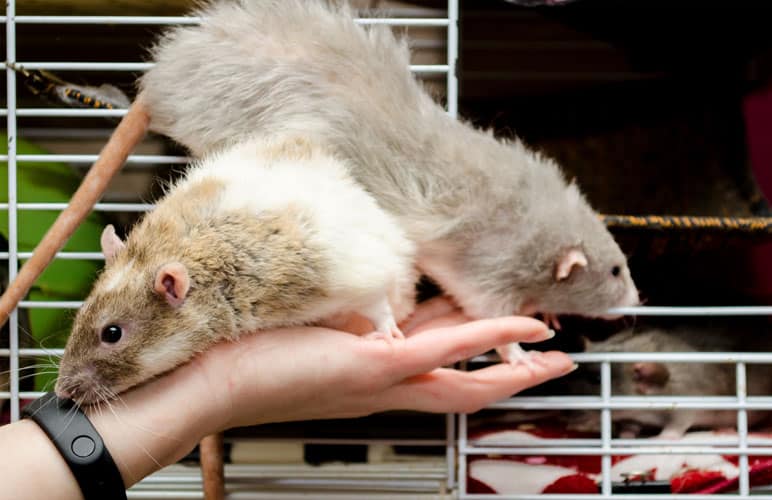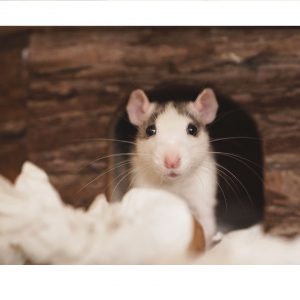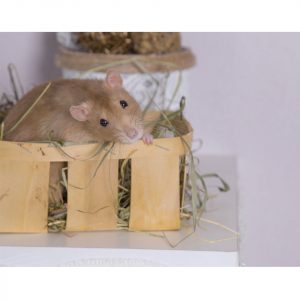Rats are exciting and entertaining pets.
Due to their size, you should keep them in a cage, so giving your beloved rat a clean and peaceful home is necessary.
To build up a suitable home for your little rat, you must maintain their cage, ensure that they are comfortable, and pick the correct sized cage with your pet’s developing age.
It might be exciting to have a pet rat; however, you’ll have to ensure it stays happy, healthy, and safe in its new setting.
Cage Size For A Pet Rat (Calculator)
Each rat requires a minimum capacity of 2.5 cubic feet in its cages. When owning two rats, their cage should be 8 cubic feet in volume.
Rats may get aggressive and engage in conflicts if their cage is too small. One way you can check the cage size, depending on the number of rats, is by using this cage size calculator.
Some individuals choose to install a smaller cage for baby rats. Young rats develop within 3–4 months, and you must upgrade to a bigger cage by that time.
Therefore, it’s advisable to have a spacious rat cage as soon as possible.
Ideally, you should keep your rats in groups while housing them (or in pairs).
They have a strong sense of social interaction and require companions to prosper. Therefore, a rat cage must be large enough to accommodate at least two rats.
Theoretically, a cage must be broad and tall enough for your little pet to stand straight on its rear limbs without hitting the roof.
There needs to be sufficient space to allow your pets to climb everywhere.
A cage should measure at least 50cm (20 inches or 1.6 feet) in height; however, this is especially important if you own energetic female rats.
Since rats always enjoy climbing, the higher the house, the better since they choose to build their homes wherever they could have the best view.
Smaller single-level cages are usually an excellent choice for senior or handicapped rats, especially bucks. It is beneficial to those who cannot move around.
These are usually for indoor bunnies, but if your pet rat is an adult and has reached its maximum height for the ample bar width, they may be excellent cages in those cases!
Where To Put Your Rat Cage?
The location of your rat’s house is equally significant as the home’s design and furnishings.
Since floors have airflow, installing the rat cage on a desk or other raised place is ideal than keeping it on the ground.
Besides being protected from the harsh sun’s rays, their cage must also be far from kitchen smells and hot air conditioning equipment like room heating systems and purifiers.
It’s certainly not a good idea to be in noisy locations (not near television or living room). Another unwanted place is one with humid conditions or hazardous toxins (laundry area, bathrooms, storage room).
What is the best location for the cage? To make your pet a precious family member, place it on a tabletop in a bedroom, you visit regularly.
Any suitable area in the family room, lounge room, or guest bedroom area is an excellent choice.
Your rat would love to watch you and other family members throughout their day!

So your pet rats can rest and prepare for the coming day, their cage should be where they can get at least 8 and 12 hours of silent, dark hours.
You should remember that rats become hyperactive during nighttime and might make some noise while eating and playing.
For that reason, you should keep them in a room where you spend lots of time in, but not where you sleep. This way, their noise won’t wake you during the night!
What to Put In a Rat Cage?
Now that you know where to put your rat cage, you might wonder what to put in it.
You can put many things in a rat cage, but we’re going to talk about the essentials in this article.
Hideouts
Anything may serve as a hideout, including a PVC pipe, a little piece of cardboard, a plywood tube, and even a miniature wooden or silicone house.
Rats love to hide under and shred cardboard; thus, you must replace it regularly.
Materials with paint or glue should be avoided since they are toxic.
It’s also important to watch for deterioration in everything composed of plastic or hardwood. Remember that it’s hard to properly clean any wood objects that get dirtied with feces or food.
If your pet rat starts nibbling on anything made of plastic or timber, swap it with anything safe for chewing.
Hammocks like the Alfie Pet or the Lixit Critter Space Pod on Amazon are excellent and safe hideouts to keep in their cage!
Chew toys
Provide a wide range of games for your pet rat, such as toys for brain stimulation and objects that swing from the cage’s highest point.
Pet rat toys (here are our favorites) should stimulate their minds since they must be doing something inside their cages. Rats enjoy chewing as well!
For this behavior, plywood hamster bars and gnawing sticks work great; however, don’t limit yourself to the rat area of the local pet shop.
Cat toys with bells could be an absolute blast as well. Toys with little bits, like pearls, should be avoided, however.
A wheel treadmill is also a fun toy that provides them with some physical exercise. This wheel by Kaytee that you can find on Amazon is a great example!
Female rats are more active than males; however, both sexes require equal exercise.
It’s a good idea to provide a variety of climbing toys. Since rats enjoy climbing, be sure they have enough accessories and toys to do so.
This Niteangel suspension bridge is a perfect addition since it provides several different activities!
Rats require a lot of intellectual activity; things like riddles, disposable paper tubes, and paper balls could be highly beneficial.
We like to use old toilet paper rolls and fill them with some paper, along with some treats, so our girls can play and get rewarded with them.
Put A Rat Hammock In The Cage
Hammocks are a must in your pet rat’s cage!
They provide ample space for pet rats to sleep in, but many also provide a hiding spot to feel even safer and warmer.
You can buy or build them. You can make a great hammock for your pet rats using old fabric or clothing at home and some shower curtain hooks.
Alternatively, you can find many of them on both Amazon and any pet store near you.
Besides the Alfie Net we mentioned above, the Niteangel Bunkbed is also a great choice!
There is a lot to know about hammocks, and we guide you through it in our Hammock article, which also includes instructions to build your hammocks.
Cozy And Warm Bedding
Pet rats are susceptible when it comes to temperatures. Even though they can handle the cold better than warm weather, it’s essential to provide them with enough bedding.
For the ideal bedding, choose materials like paper or cotton; however, avoid fragrant beddings that can harm your beloved rat.
Dusty and fragrant bedding can harm your rodent’s kidney and lung systems.
Crushed paper is an excellent bedding option for your pet, so we always recommend the Carefresh Paper Bedding.
You can also use fabric bedding, like old shirts, provided the fabric does not tear quickly.
These pieces of fabric make for excellent bedding to put into their hiding spots! This way, your pet rats can create a warm and comfortable nest.
Water Bottle
Your pet rats must always have water available to them. A water bottle is a good idea to avoid accidents and optimize the cage space.
Water bottles for rodents aren’t expensive and can hold much water. They are easy and comfortable for your pet rats to use.
Not only that, but since they can be attached to the outside of the cage, leaving the drinking tube turned into the cage, you have extra space for more toys!
Food Bowls And Feeding
Additionally, you’ll need a tiny to medium-sized feeding dish. This dish should be heavy so your pet rats can’t overturn it by accident.
We like to use these stainless-steel food bowls usually made for cats. Due to their design, they’ll keep in place, so your pet rats can eat comfortably.
If you notice your pet rats do not enjoy the metallic sound, a ceramic bowl can also work!
Litter Tray
Pet rats are very clean and organized, so they’ll usually choose a specific cage place to do their necessities.
Therefore, getting a litter tray is an excellent addition to their cage. This way, they have a proper place to relieve themselves while keeping the cage cleaner for longer.
This Lixit Corner litter pan is one of our favorites since you can easily set it up on a corner of the cage.
If you own more than a pair of rats and have a big cage, consider putting at least two litter boxes, so they have different places to go.
It’s also important to note that the litter you use differs from the one you use for bedding. This way, your pet rats won’t get confused!
Fleece Blankets
So the floor cage is softer and more comfortable on your pet rat’s feet; many people line it with fleece blankets.
The fleece blankets are good for their feet but maintain a warmer temperature in their cage, especially in the winter!
You can purchase a queen-size sheet and divide it into parts as needed. Just measure the floor of the cage and cut it accordingly.
Boxes
You could have fun with boxes in a variety of ways. Cut doorways on every corner to provide your rats with access points.
By cutting or transforming parts of a box, you can make a comfortable bed for your pet rats! Just add a T-shirt on the surface to make it even snugglier.
Cereal, ice cream, or even some mailboxes can provide great fun for your pet rats.
Keep them somewhere and replace them as they get damaged or are too dirty.
Wrapped Treats
Pet rats love puzzles and rewards, so leaving some wrapped treats around their cage sometimes is a great exercise for them.
You can do this by using a small piece of paper, put some of their favorite snacks in it, wrap it and leave inside their cage.
Let them explore and play, while eating some delicious treats!
To make it more of a challenge, you can use toilet paper rolls for this as well, get some pieces of peper, along with some snacks and let them play.
Can I Let My Pet Rats Roam Out Of The Cage?
If you oversee them, you can let your furry friends walk freely around your entire home. You may rat-proof a specific location and keep an eye on the rats while out of the cage.
You may use a training pen with tight bar gaps or concrete walls to restrict your pet in a play area. A pet playpen does the job wonderfully.
It’s also possible to use big cardboard boxes to act as walls and create a playground with them!

Alternatively, if your little friend prefers to cuddle with you, you may just relax and read a novel or binge-watch your favorite shows while your rat is on your tummy or in your arms.
Rat Cage Setup Ideas and Tips
There are a lot of fun toys and stimulating objects that could keep your rat engaged for a long time.
As we’ve seen, pet rats need activity. They need to move their bodies but also exercise their brains.
They can get easily bored if there are insufficient objects, toys, and accessories to interact with.
There are many things you can do and add to their cage or even playground so they keep themselves entertained.
Most of them you can buy at any pet store or online, but you can make others yourself!
Surprising Foraging Toys
That’s the best example of how you can easily engage your pet using their natural senses.
Since rats are curious animals, they require something to keep up with their instinct to forage for treats or food.
That means you can easily hide their favorite snacks or toys rather than giving them upfront in their food bowls or cage.
So, to help with that, you can buy many small toys which are challenging and fun to play with by hiding food in them.
You can buy forage feeders and puzzle games or make one, using cardboard boxes and shredded paper.
Just avoid printed paper, since they might chew on it and the ink is toxic.
Again, you can also use paper roll; you can watch your rats have fun finding their food with these rolls.
This is a great exercise for them, since it challenges them to get their own food. Makes the whole thing much more exciting!
Play Hide And Seek With Tunnel Toys
Rats love to dig holes and hide in safe corners. With tunnel toys, your rat can hide inside and escape from the outside world for a relaxing nap.
If you have a cage with a height of more than 6 inches, you can quickly fix some PVC pipes or toy tunnels.
You can put these tunnels inside a card box and leave one end opened outside for easy access.
Your rats will love this concept of digging into the pipes, adding their creative touch, and turning it into a maze.
Just make sure the pipes are wide enough for your rat to move freely and not tight for them.
On Amazon, you can actually find tubes for rodents, in many different colors. This way you know they are proper for them!
Exercise Wheels
Some pet rats love wheels, others are a bit more resistant to them.
That’s why it’s important to introduce it to them at very early stages. When they first get to their cage, a wheel should already be present, so they can get familiar with it.
This way, sooner or later they’ll be brave enough to explore it.
It is equally crucial for your rat to get adequate exercise to stay fit and mentally active.
While looking for a perfect wheel, go for solid and hard materials like wood and plastic.
Also, ensure the wheel has a diameter of at least 11 inches so your rat can efficiently run without getting hit by the wheel sides.
You should install the wheel on the lowest surface possible, as fixing it to the highest height could increase the chances of your little pet falling and getting hurt.
Alternatively, you can also let them run on their wheel whenever they’re out of their cage.
Place the wheel on their playground and let them run as much as they want!
Climbing Toys
Your rats would love you for getting them toys to climb.
Installing ropes, ladders, pipes, plant branches, slides, boxes, soft walls, etc. will make your rat cage look great and keep your pet entertained all day.
Not to forget, it will help them move from one level to another.
Make sure you pick a solid material for these climbing toys, and they don’t hurt your pet.
For example, many tree branches have small pointy ends that could badly damage your rats.
You also need to check if the toys are non-slippery, as no matter how strong or intelligent your rats are, they could slip from them.
Keep the climbing toys only an inch above the surface so your rats can easily maintain their grip and not fall.
Usually, getting climbing toys proper for rodents are safe enough, so you can’t go wrong with them! The Niteangel Suspension Bridge is a good example.
Chewing And Digging Toys
We are talking about those cute and powerful teeth that hold power to shred anything in no time.
All animals naturally desire to nibble and chew on things to keep their dental health intact. This goes double for pet rats, since their teeth are always growing.
For that reason they need proper toys to chew on.
It’s your responsibility to provide your pets with safe and easy-to-chew toys that will stimulate their minds and keep their teeth strong and free from dental problems.
You can try and offer them safe woods like apple, pear, grape, and passion fruit, as their wood is safe for your rat’s teeth.
Again, there’s a big number of chewing toys you can get your pet rats, like the Kaytee Perfect Chew.
Pet rats enjoy toys that have different shapes and colors, and these hit all the marks!
Make sure you provide your pet with plenty of options to choose from and see how they like different chewing toys and treats.
If you notice the toy getting smaller after a few days of usage, replace it with a new one.
Smaller toys could break down quickly, and those tiny bits could get stuck into your rat’s digestive tract.
Another thing to have into account is that pet rats will get bored with the same toy over and over.
It’s a good idea to keep a good stash of them and rotate the toys in their cage every week.
While digging and shredding toys are easy to find and use since they are simple for tearing purposes.
Old clean clothes, card boxes, straws, paper balls, etc. could make great shredding toys.
Just like chewing toys, these teared-up toys must be replaced regularly.
Now that you know everything about setting up a rat cage, learn how much exactly you should feed your pet rat in our guide here!




